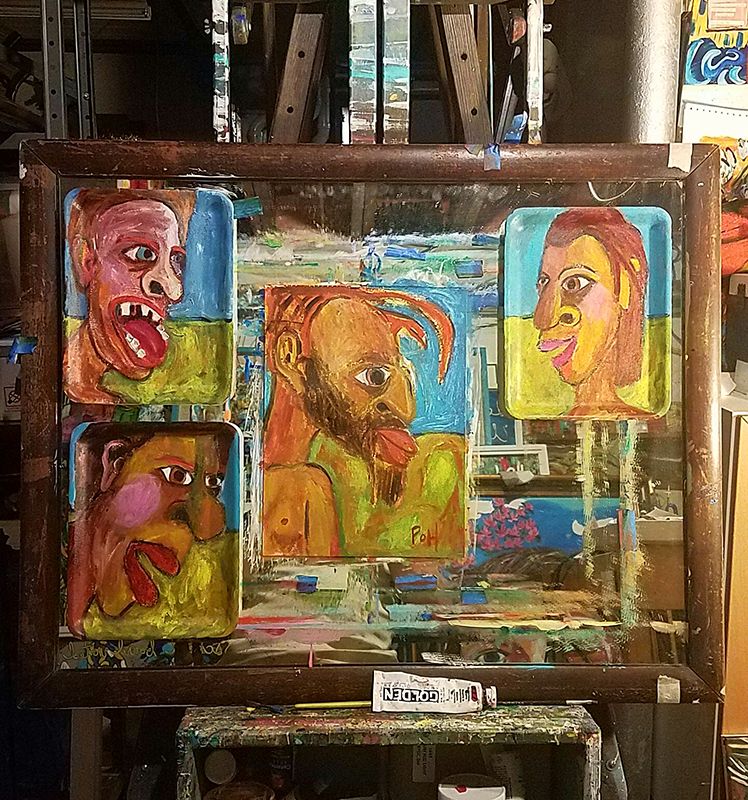
Harry Heidelbergensis and His Three Sisters (Wives) 2021.
Acrylic on paper and foam.
Price: @$17 (2.5) + M + Element “X” = $55.25
My granddaughter paints. She is not an artist but she makes darn good art. She always finishes a piece she begins, usually before a half hour is up. She doesn’t care if you like her painting because she knows that you will. If she ever expected to get paid for her portrait of Grandpa, we would deem her a business savant or insane. She is neither. Just another wonderful child making art for joy and love. They’re everywhere.
Adult artists go to work, not to jobs or careers. They reside in economic limbo. For too many of these poor souls, recognition via income is a never-ending purgatory teasing up or down. This is a crying shame for so many folks who make art, and a waste of time for the artist who wakes each morning “…to be the first to adore—Christmas on Earth”.
Recently I wrote about class and the shelters afforded us according to our place in society. We have jobs and careers to rent or buy our lifestyles. They provide an overall picture of socioeconomic status. Paid labor has names like “Assistant to the Secretary, Chair of the Philosophy Department, Cashier, Walmart Associate, Corrections officer, Broiler cook, Manager of the Toledo Parts Division, etc. Euphemisms to let the stranger and IRS assess in a second how a person’s bread gets buttered. They define what level of social “worth” a human being can reach. All are links in a wage slavery chain, that is both the bane and salvation of modern society.
Many artists are wage slaves by proxy. Without jobs or careers, full time artists live like paupers if not supported by a mom, millionaire, wage slave partner, or some other arrangement that works in the artist’s favor (a trust fund for example). Most often it’s a wage slave partner, since millionaires couldn’t handle a determined creative mind for one more minute of conversation, and trust funds aren’t known for inspiring hard work art returns from their recipients. Artists without support find it practically impossible to remain afloat financially. It can be done, but it takes a load of moonlighting to garner success. Not only is “the business of art” an oxymoron, but a full time job all by itself. Sorting, storing, mailing, banking, advertising, marketing, social media activity—one makes him or herself a retail company with a product “art” straight off the assembly line. In the United States, insurance companies have forced talented doctors to moonlight as business people. Practices are heavily burdened to keep up with the red tape in the health care “business”. Art academia, government, and the “high art” market control the power and influence (and money) allotted to individual artists. There is no job available for an artist to “make art”, no wages are paid out for future inspiration and whimsy. The same goes for the vaguely defined “career artists” who must rely on subsidization by a higher financial power for snippets of decent pay. Whether that be a government art grant, a popular art fair scam, a solo exhibition at an academic art gallery or art museum, a billionaire-cooked auction at Christies®, or a doting wife (my case). In assessment of art economy I rarely include career track professorships since they are bound by wage slavery as much as a dishwasher or office receptionist. They are jobs in themselves and art a free time hobby or ambitious moonlighting pressure.
To further complicate the matter at hand, there is no fixed price on art. It’s a commodity anomaly. Fred’s painting of a pig can net a million bucks at private auction while Rita tries to sell hers for $10 at a garage sale with no luck. We know roughly the price of bacon, no matter which specific pig gave up the ghost. The same for flashlights, computers, envelopes, and college educations. Prices are more or less fixed for the vast multitude of commodities. This is normal and sane for all things to be purchased. Society accepts the cost of nearly everything besides art.
Why is that?
Celebrity and ubiquity.
Celebrity is obvious. It is the main reason for the vast economic divide in the art world. Levels of celebrity will set the price for an artist’s work, whether international or local. The often heard claims of subjectivity do not apply here. A Banksy stencil of a rat is world renown. Nearly everyone agrees it’s formulaic and boring. But it’s the famous Banksy, so here’s $200,000 dollars. At the community art association in the Houston suburbs, retired rodeo star, Cowboy Joe, exhibits stencils of aggravated horses, and sells them for $500 a pop. He might have been a great cowboy, but he’s definately a boring artist. Somewhere in between Banksy and Cowboy Joe are the artists (and non artists) who are already famous in one genre and delve into another knowing their celebrity has the Midas touch. Bob Dylan selling paintings and welded gates comes to mind. Not so poised to add anything new and interesting in the name of art, but always ready to make a buck on the scam market. Name recognition is influential. Winners are made and losers unknown. From Michelangelo to the present day, celebrity art is artificially made expensive and therefore reserved to trade by the very few.
There is a larger though poorer circle of living artists centered around the cult of the academic. Name dropping in master’s theses, write-ups in museum catalogues, and the “industry” influence of art agencies garners enough interest to raise the reputation (value) of artwork by artists and academics making art. “Worthy to write about and/or exhibit” is set by an internal “art club” in colleges and universities. Today in higher ed it is anathema to expect subjectivity that hasn’t first been vetted by another recognized and established authority. What ensues is an infinite loop of watered down expression. Resumes matter. The “CV” requested of applying artists stands for “Correctly Vetted”.
Is to be denied entry into an established power structure really such a bad thing to happen to an artist? Yes, if he or she ever wants to earn a fair wage for art, or at the very least price their work respectfully and meaningfully. Lucrative art and artist are objectively “made” by non-creative people with money. “To be made” means that the artist never wants for access to an Olympic-sized swimming pool or a hundred dollars cash. The makers (non-creative people with money) take the chosen art and artist and sell it over and over again for profit. It’s a well-known and accepted scam played by anyone making over $50 a day in the art world. Without Jeff Koons, for example, there would be no more ArtNews, Artnet, or New York Times Arts section disseminated by millionaires via their salaried editors to curious (bored) middle class careerists. New York galleries couldn’t afford the rent exhibiting unknown Tom’s excellent painting of a nude on a dune buggy, or unknown Sheila’s carved marble statue of a panda bear. It’s the made name that opens the door and brings down the house (and makes non-creative people with money richer).
Where were all the established art movers and shakers when van Gogh was alive and exhibiting? Any influential earthlings with subjective expertise in 1880? Of course! But van Gogh was a an ignoramus of his day. Not salon worthy at all.
Who said so?
The non-creative people with money of course!

As Ugly As Some Things Must Be, Eyes Should Make You Want to Care For It 2021.
Acrylic on Rolling Stones Album, “Got It Live If You Want It!”, 12 x 12”
Price: @$17 (1) + M + Element “X” = $31.20
Obviously, modern celebrity has some effect on the subjective pricing of art. However, I believe ubiquity is king influencer. Today, a billion people on earth (perhaps more) have the time and means to express themselves by practicing an art. Economies of wealthy nations support free time like never before. Whether it’s watercoloring landscapes for Christmas gifts, or siding your house with paintings of giraffes, millions and billions of creative people are out carbonating the atmosphere like maniacs, screwing up natural processes, denying evolution.
Too many of us are making art. If the majority were actually paid for what they thought their time was worth, economies would dissolve into forever silence. Wage slavery is a god sent stabilizer for industrial and service economies like ours. The great majority of people must work jobs or salaried positions in order to preserve access to luxuries we have come to expect (e.g., smartphones, fast food and toilet paper). It’s a kind of “herd immunity” to avoid complete economic shutdown. If art paid a living salary to any maker of art, then who would take an unwanted job ever again?
This is a good thing for humanity, yet very unfortunate for the artist species.
I believe art is a useless, incredibly necessary anti-commodity, sort of. It’s its own thing and remarkably undefinable. Art is made by artists and art is made by non-artists. There is a wide stamina gulf between the two human beings, if not the actual art that gets created. For instance, my granddaughter makes art but she is not an artist. Her father, who is a salesman, cooks an excellent curry on Saturday, but would not claim to be a master chef. Any person at any time can make art, which renders art ubiquitous and therefore subjectively worthless, priceless, or, if we desire a sane marketplace, price-fixed somewhere in between, with a common standardization. No one besides family will buy the grandchild’s art, and the home kitchen curry is only worth the price of a curry anywhere. I paint and write because I am an artist. Likewise, I abide by a personal philosophy because I am an artist. I also saute tofu and roast chicken because I am an artist. And I chant the following mantra inside my head all the far-reakin’ time, because I am an artist:
Side by side with the human race there runs another race of beings, the inhuman ones, the race of artists who, goaded by unknown impulses, take the lifeless mass of humanity and by the fever and ferment with which they imbue it turn this soggy dough into bread and the bread into wine and the wine into song. Out of the dead compost and the inert slag they breed a song that contaminates. I see this other race of individuals ransacking the universe, turning everything upside down, their feet always moving in blood and tears, their hands always empty, always clutching and grasping for the beyond, for the god out of reach: slaying everything within reach in order to quiet the monster that gnaws at their vitals. I see that when they tear their hair with the effort to comprehend, to seize this forever unattainable, I see that when they bellow like crazed beasts and rip and gore, I see that this is right, that there is no other path to pursue. A man who belongs to this race must stand up on the high place with gibberish in his mouth and rip out his entrails. It is right and just, because he must! And anything that falls short of this frightening spectacle, anything less shuddering, less terrifying, less mad, less intoxicated, less contaminating, is not art. The rest is counterfeit. The rest is human. The rest belongs to life and lifelessness.
—Henry Miller from Tropic of Cancer
This passage does not apply to all artists. I use it to identify my general feelings about art and artist, terms that get overused like “Kleenex” in a sloppy art world. Miller’s portrayal of the artist is kind of grim and painful-looking. Does Beyonce do these things to herself? Did Andy Warhol?
Art and artist in the modern age will be a topic for another day. Today I am wondering about art work and how to get paid for it.
This week I dedicated 28.5 hours to painting pictures so I could come up with a “wage” for my art. I set out to fix a pricing system for my work that I felt to be fair. Always fair, with no surprises. Because there isn’t a standard pricing model, potential buyers (and artists too) have no idea how to price art.
At living purchase (art that is bought directly from a living artist, not art that is traded by speculators after the sale), work must be valued by what an artist feels his or her labor is worth (wages or “W”), plus (materials or “M”) plus an “element “X” fee (30% of wages plus materials, or .30(W + M). The “element X” is the thing other people don’t have. It’s the reason art is purchased and not made by the buyer. The wage to be set is entirely up to the artist. If I paint a willow tree and Rita paints a willow tree, and neither look like a willow tree, perhaps we’ll both be satisfied with minimum wage (to be $15/hour soon in the U.S). Or, Rita sets her wage at $50/hour because she believes that her willow tree has a transcendent “untree” sort of genius about it, and will raise the aura of a living room to heavenly heights. The thing is, Rita, or any artist sets their own hourly wage, never lower than the legal minimum, so that everyone can see in the open what the artist expects for the piece at hand. It won’t be random. This method works especially well for commissions. There’s a landscape painter I’ve watched on Instagram® who I know could get $40/hour for her time, at least. Nobody will come to me for a sylvan scene after they’ve seen her work. 25 bucks more an hour for her painting will be worth the investment.
In the latter case, the playfulness of art can still remain. Let’s say for experiment we’re both tasked with painting the buyer’s backyard scene on a 16 x 20" studio canvas ($3). She uses fine oils ($18), and I use craft acrylics ($1.50). Her piece took 10 hours (@ $40/hr = $400)). Mine took 20 minutes (@ $15/hour = $5). Her painting is actually quite beautiful, masterly even. Mine looks like a scribble over a dead animal. The final cost for her piece: (W(wage) + M(materials) + 30% (W + M) = $547.00).
My asking price is $11.05.
Turns out the commission was to be a birthday gift for an abusive father, and the buyer chose my painting. Lucky me.
This is how I believe artwork should be priced. When standard, fair, and understood by all parties involved, art is no mystery. It is what it is. The artist fixes a wage which is the first step in pricing the piece of art. What is your time worth artist, and you realize, of course, that it doesn’t matter? It’s taken 30,000+ years, but we have finally managed to put a price on all living art meant to be sold in a marketplace. For modern times this should come as great relief to the artist who feels ostracized in a society running smoothly on wage slavery. If working people want art in their lives, there is a price for it. But its a fair one, and universally figured by a standardized, market-friendly model. Like olive oil or French wine. Maybe art will have its heyday as a commodity and push grotesque valuables like gold and silver and Tesla Motors over a cliff where they belong. Who knows?
Now what happens when the artist sets his or her wage, and no one ever buys the painting, sculpture, or song that she wrote? And this will certainly be the case for the vast majority of art makers.
Well, it will separate the wheat from the chaff. The artist does not make art because there is money to be had. My granddaughter paints a picture for joy and love. She’s not yet an artist because she hasn’t been confronted with a choice not to be. All three year olds make art. Just like all 50 year olds are capable of doing, but choose not to. Those who do and expect to be paid, are definitely making art, but not artists necessarily.
I painted from 12 - 4:30 p.m on Sunday, 8-4:30 p.m. with an hour lunch, Monday through Wednesday, and 1-3:00 p.m. on Thursday. I made time to write this and do the other things to maintain a household—mostly cook, spot clean, and fold laundry.
I painted like it was a job in order to determine a wage that has not yet been set. But now, after the 28.5 hours, I’ve come to a decision. Although I am an artist through and through, the art I make is mediocre at best. This is okay by me. It does not harm my pride because I know I am an artist. It’s just the truth, my truth, and I hope to make a buck or two when I can while playing out the rest of this life as an artist. It’s up to you, the buyer, to find what you like. Sometimes we want a hamburger and fries. Some nights we dream of a private dinner at the Plaza. My work adds a chocolate milkshake to your fast food meal. 17 dollars an hour please.
Here is a list of the rest of the paintings (and their pricing) from this week. Buy some if you’re feeling hungry. You’ll get your money’s worth (and perhaps a little indigestion).
First, the equation:
Price = [W(wage • hours worked)] + M(materials) + Element “X” (W + M)
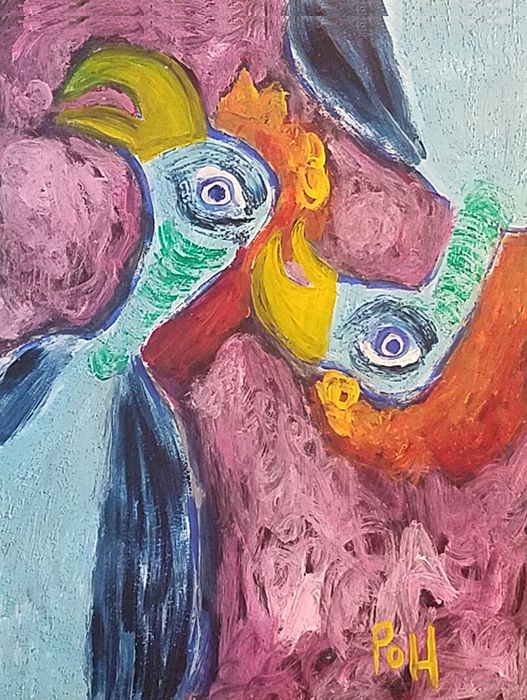
Arctic Carrion Parrots Checking Out New Meat 2021. Acrylic on paper, 11 x 14"
Price: @$24 (1) + M + Element “X” = $37.30
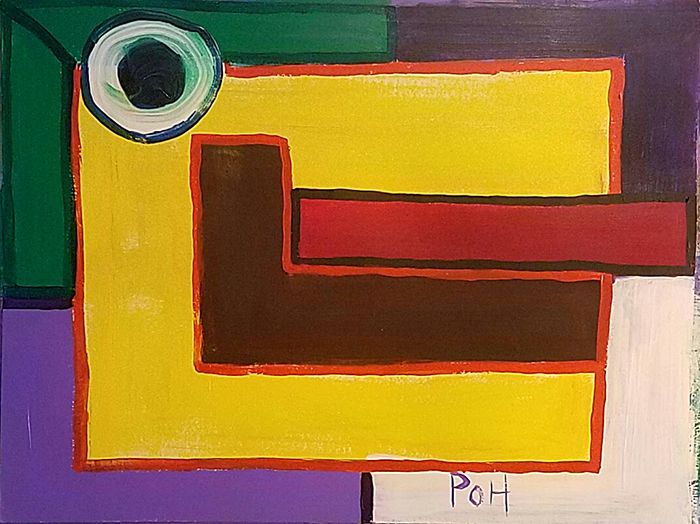
Playful Dog 2021.
Acrylic on paper, 14 x 11"
Price: @$24 (1) + M + Element “X” = $37.30
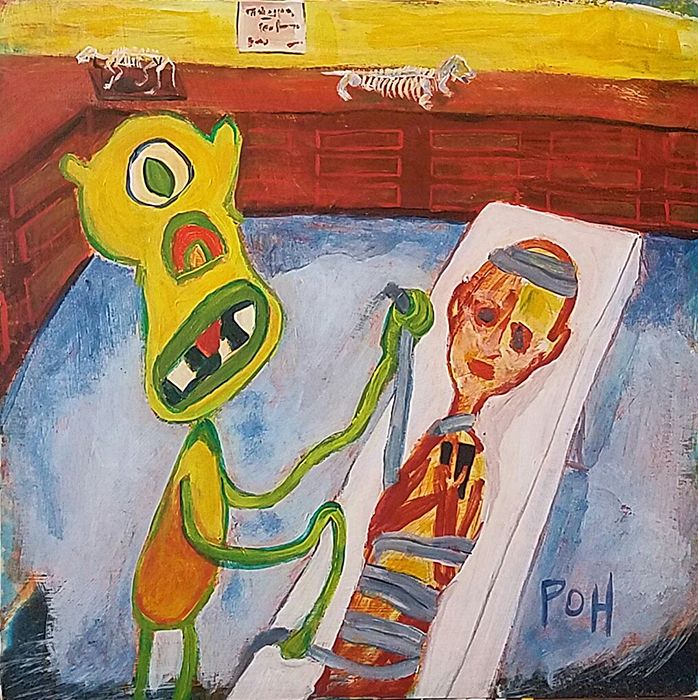
Future Archaeologist Unraveling Shroud of Baltimore Man 2021.
Acrylic on Bob Dylan album “Bob Dylan’s Greatest Hits”, 12 x 12"
Price: @$24 (3) + M + Element “X” = $119.60
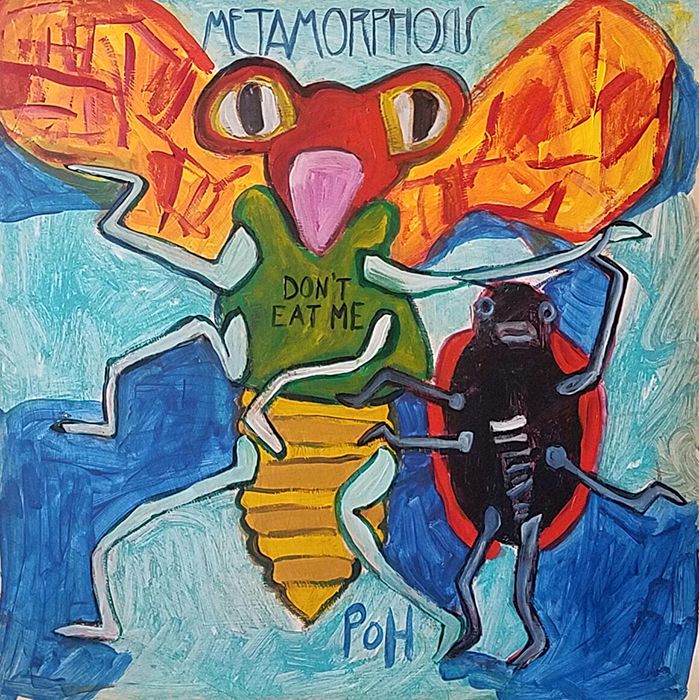
Love is Our Drug 2021.
Acrylic on Rolling Stones album “Metamorphosis”, 12 x 12"
Price: @$24 (2) + M + Element “X” = $88.40
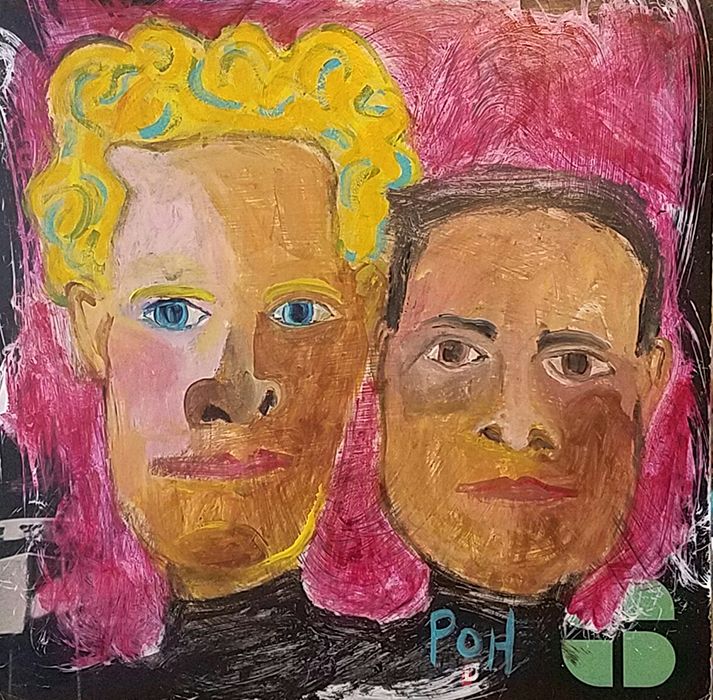
The Singer and the Poet and the Singer 2021.
Acrylic on The Doors album “Alive She Cried”, 12 x 12"
Price: @$24 (2) + M + Element “X” = $88.40
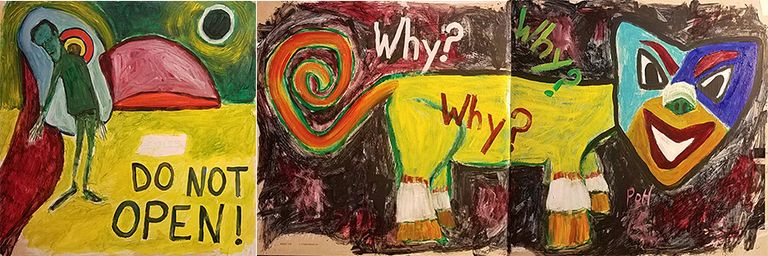
Do Not Open This Painting 2021.
Acrylic on Beatles “White” album, 12 x 12"
Price: @$24 (3) + M + Element “X” = $119.60
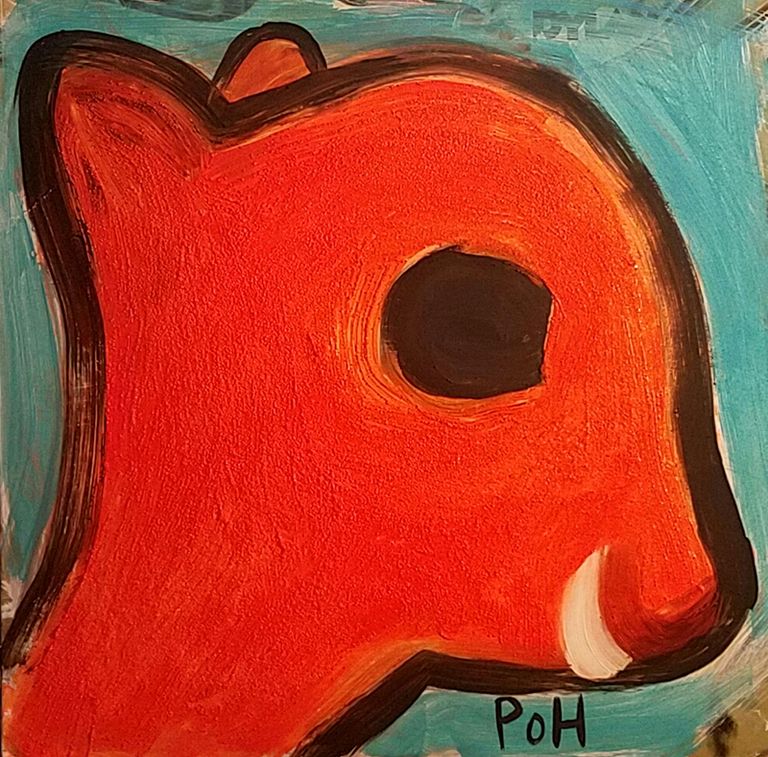
Fluorescent Orange Squirrel 2021.
Acrylic on Bob Dylan album “Dylan”, 12 x 12"
Price: @$24 (1) + M + Element “X” = $57.20
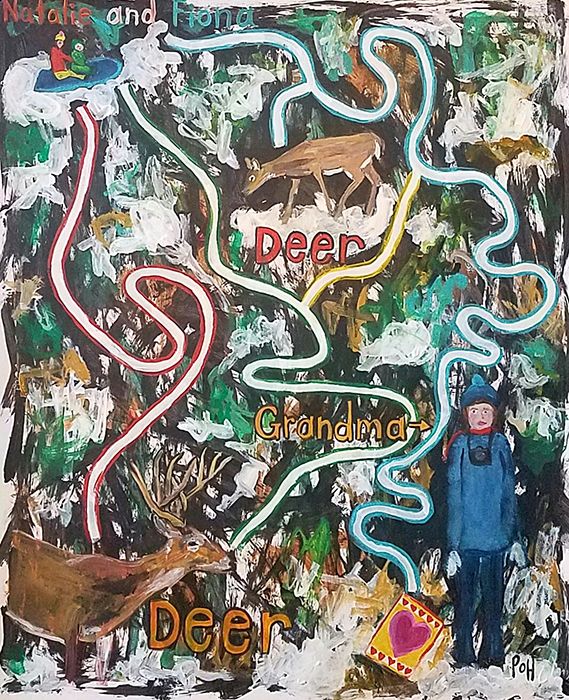
Valentine’s Maze for Granddaughters 2021.
Acrylic on paper, 14 x 17"
Price: @$24 (3) + M+ Element “X” = $119.60 (NFS)

Self Portrait From the Year This Album Came Out 2021.
Acrylic on Rolling Stones album “Undercover”, 12 x 12"
Price: @$24 (1) + M + Element “X” = $57.20

I Wouldn’t Last a New York Minute at This Party 2021.
Acrylic on Rolling Stones album, “Tattoo You”, 12 x 12"
Price: @$24 (2) + M + Element “X” = $88.40
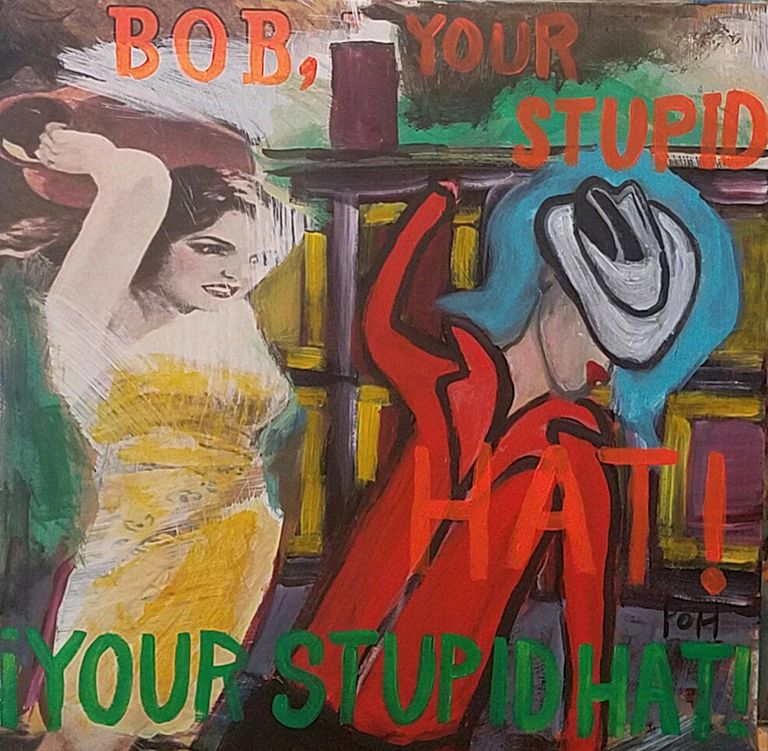
I Should Have Been a Chef 2021.
Acrylic on Bob Dylan album “Knocked Out Loaded”, 12 x 12"
Price: @$24 (2) + M + Element “X” = $88.40
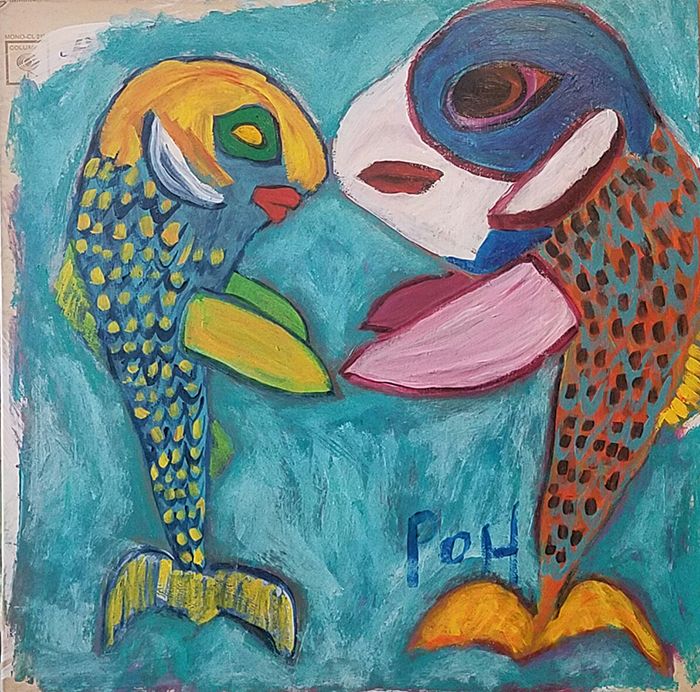
Midsummer Night, 2021 2021.
Acrylic on Bob Dylan album, “Another Side of Bob Dylan”, 12 x 12"
Price: @$24 (2) + M + Element “X” = $88.40
Let’s imagine some rich industrialist steps out the back of a 1954 Rolls-Royce, and walks up to my studio door (I won’t let him in because of the coronavirus). He wants to buy the entire work week output (I’ll allow the maze for my granddaughters just for math’s sake).
Here is the bill I present without tax or gratuity:
$976.30
If I had this success every week for a year (with two week vacation), my gross annual income for part time art-making employment would be $48,815.00. Very gross, since this number doesn’t account for any other overhead, and all the other manias of business previously mentioned. Still, I believe it to be fair overall for part-time creative work in an insane economy.
Please spread this art pricing guide far and wide. I expect all artists to begin implementing it by the first of the new year.
Thank you!
Ron
Interesting writing. Even though I'm not an artist, and I don't understand painting, I've always loved artistic things. In my opinion, the lack of appreciation that an artist gets is because the general public does not fully understand the artistic value of a work that is produced.
In addition, changes in society's culture towards materialistic, also affect the world of artists. This condition then forced the artists to compete with each other to get recognition for the work produced, which was measured by the value of the currency.
"Artists are people too, and need money to live" is the phrase I hear most often these days. Therefore, most artists today are willing to pawn themselves into wage labor, instead of defending their ideals and values of freedom. Whereas the real price is the spirit of their freedom to express everything without any pressure, including money.
You’re absolutely right!
Henry Thoreau said the same about philosphers in 1845:
“There are nowadays professors of philosophy, but not philosophers. Yet it is admirable to profess because it was once admirable to live. To be a philosopher is not merely to have subtle thoughts, nor even to found a school, but so to love wisdom as to live according to its dictates, a life of simplicity, independence, magnanimity, and trust. It is to solve some of the problems of life, not only theoretically, but practically. The success of great scholars and thinkers is commonly a courtier-like success, not kingly, not manly.”
Painters do need to get paid fairly in the rare occurrence that a painting is purchased. My article (with its equation) sets a standard so everyday artists (like myself) can buy pasta and pay the rent:)
I do not think society is materialistic, in the manner that they treasure material things, but is more wasteful, lacking imagination and with shorter attention spans. A good materialist would love art and many types of curiousities. Waste is my culture. Want and waste.
Thank you so much for your perspective. “Defending their ideals and values of freedom”. You just gave my day a huge boost!
Glad to have found this article and can discuss it with you.
Congratulations, your post has been curated by @dsc-r2cornell. You can use the tag #R2cornell. Also, find us on Discord
Felicitaciones, su publicación ha sido votada por @ dsc-r2cornell. Puedes usar el tag #R2cornell. También, nos puedes encontrar en Discord
Thank you so much!
Also, keep in touch with Blurtconnect-ng family on Telegram and Whatsapp
Congratulations, your post has been curated by @techclub
Manually curated by @samhenrytenplus
Thank you!
Wow awesome read thank you. I will share this around I think the art community here in Ghana would even enjoy this.
Thank you! What an honor! Please share, and talk. It’s what artists must do:)
To you and yours!
Congrats sir your post is really instructive...
Thank you very much! I would be so happy if it actually worked half the time:)
It's amazing how much I enjoyed this post as I can relate to it in so many ways. As an artist you reach a point where you feel a huge penumbra if you want to make paintings your only source of work, gods I wish, but it is impossible or at least for me and much more being in my country.
I have a salaried job with which I cover my expenses, and I make art a source to diminish my anxiety mostly, I will not deny that sometimes it is quite difficult and over the years in some platforms like Blurt I have been able to afford many materials which in my country are not at all economic.
It is always good to see you showing such interesting paintings.
Thank you for the support. It means a lot coming from another painter. You get it. I get it. Let us set our wage and hope for the best. Meanwhile, continue to make art to offset and/or express the persistent anxieties. And let us be careful what we wish for. I have a breadwinner to care for my needs, complete freedom, and an economy that gushes, yet every day I have to kill the ego to make something new (to me). I think freedom is a blessing and a curse. I have freedom out my ears and the curse is the tendency to waste it.
Always merry and bright!
Ron
great advice thankyou x
Thank you for reading:)